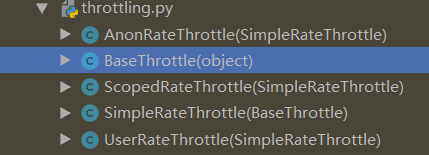一 频率简介:
为了控制用户对某个url请求的频率,比如,一分钟以内,只能访问三次
二 自定义频率类,自定义频率规则:
自定义的逻辑
#(1)取出访问者ip # (2)判断当前ip不在访问字典里,添加进去,并且直接返回True,表示第一次访问,在字典里,继续往下走 # (3)循环判断当前ip的列表,有值,并且当前时间减去列表的最后一个时间大于60s,把这种数据pop掉,这样列表中只有60s以内的访问时间, # (4)判断,当列表小于3,说明一分钟以内访问不足三次,把当前时间插入到列表第一个位置,返回True,顺利通过 # (5)当大于等于3,说明一分钟内访问超过三次,返回False验证失败
代码的实现,views.py代码
from rest_framework.views import APIView from rest_framework.response import Response from rest_framework.throttling import SimpleRateThrottle,BaseThrottle #第一步,写一个频率类,继承SimpleRateThrottle #重写get_cache_key,返回self.get_ident(request) #一定要记住配置一个scop=字符串 # 第二步:在setting中配置 # REST_FRAMEWORK = { # # 'DEFAULT_THROTTLE_RATES':{ # 'lxx':'3/m' # } # } class Throttle(SimpleRateThrottle):
scope = 'lxx' def get_cache_key(self, request, view): # return request.META.get('REMOTE_ADDR') #返回什么值,就以什么做过滤,返回用户id,就以用户id做过滤 return self.get_ident(request) #自定义频率类 class MyThrottle(BaseThrottle): VISIT_RECORD = {} def __init__(self): self.history=None def allow_request(self,request,view): #自定义控制每分钟访问多少次,运行访问返回true,不允许访问返回false # (1)取出访问者ip{ip1:[第二次访问时间,第一次访问时间],ip2:[]} # (2)判断当前ip不在访问字典里,如果不在添加进去,并且直接返回True,表示第一次访问,在字典里,继续往下走 # (3)循环判断当前ip的列表,有值,并且当前时间减去列表的最后一个时间大于60s,把这种数据pop掉,这样列表中只有60s以内的访问时间, # (4)判断,当列表小于3,说明一分钟以内访问不足三次,把当前时间插入到列表第一个位置,返回True,顺利通过 # (5)当大于等于3,说明一分钟内访问超过三次,返回False验证失败 # (1)取出访问者ip # print(request.META) #取出访问者ip ip = request.META.get('REMOTE_ADDR') import time #拿到当前时间 ctime = time.time() # (2)判断当前ip不在访问字典里,添加进去,并且直接返回True,表示第一次访问 if ip not in self.VISIT_RECORD: self.VISIT_RECORD[ip] = [ctime, ] return True #是个当前访问者ip对应的时间列表 [第一次访问的时间,] self.history = self.VISIT_RECORD.get(ip) # (3)循环判断当前ip的列表,有值,并且当前时间减去列表的最后一个时间大于60s,把这种数据pop掉,这样列表中只有60s以内的访问时间, while self.history and ctime - self.history[-1] > 60: self.history.pop() # (4)判断,当列表小于3,说明一分钟以内访问不足三次,把当前时间插入到列表第一个位置,返回True,顺利通过 # (5)当大于等于3,说明一分钟内访问超过三次,返回False验证失败 if len(self.history) < 3: self.history.insert(0, ctime) return True else: return False
def wait(self): import time ctime = time.time() return 60 - (ctime - self.history[-1]) class Books(APIView): # throttle_classes=[Throttle,]
#局部使用
throttle_classes=[MyThrottle,]
def get(self,request):
return Response('')
settings.py中的代码(一分钟访问三次)
REST_FRAMEWORK = { 'DEFAULT_THROTTLE_RATES':{ 'lxx':'3/minute' } }
内置频率限制类:

BaseThrottle是所有类的基类:方法:def get_ident(self, request)获取标识,其实就是获取ip,自定义的需要继承它
AnonRateThrottle:未登录用户ip限制,需要配合auth模块用
SimpleRateThrottle:重写此方法,可以实现频率现在,不需要咱们手写上面自定义的逻辑
UserRateThrottle:登录用户频率限制,这个得配合auth模块来用
ScopedRateThrottle:应用在局部视图上的(忽略)
四 内置频率类及全局使用:
REST_FRAMEWORK = { 'DEFAULT_THROTTLE_CLASSES':['自定义频率的方法的路径',], 'DEFAULT_THROTTLE_RATES':{ 'luffy':'3/m' } }
五 源码分析:
def check_throttles(self, request): """ Check if request should be throttled. Raises an appropriate exception if the request is throttled. """ for throttle in self.get_throttles(): if not throttle.allow_request(request, self): self.throttled(request, throttle.wait()) #以及错误信息的源码 class Throttled(APIException): status_code = status.HTTP_429_TOO_MANY_REQUESTS default_detail = _('Request was throttled.') extra_detail_singular = 'Expected available in {wait} second.' extra_detail_plural = 'Expected available in {wait} seconds.' default_code = 'throttled'
错误信息的中文提示:
class Course(APIView): authentication_classes = [TokenAuth, ] permission_classes = [UserPermission, ] throttle_classes = [MyThrottles,] def get(self, request): return HttpResponse('get') def post(self, request): return HttpResponse('post') def throttled(self, request, wait): #自定义中文的错误信息 from rest_framework.exceptions import Throttled class MyThrottled(Throttled): default_detail = '傻逼啊' extra_detail_singular = '还有 {wait} second.' extra_detail_plural = '出了 {wait} seconds.' raise MyThrottled(wait)
class SimpleRateThrottle(BaseThrottle): # 咱自己写的放在了全局变量,他的在django的缓存中 cache = default_cache # 获取当前时间,跟咱写的一样 timer = time.time # 做了一个字符串格式化, cache_format = 'throttle_%(scope)s_%(ident)s' scope = None # 从配置文件中取DEFAULT_THROTTLE_RATES,所以咱配置文件中应该配置,否则报错 THROTTLE_RATES = api_settings.DEFAULT_THROTTLE_RATES def __init__(self): if not getattr(self, 'rate', None): # 从配置文件中找出scope配置的名字对应的值,比如咱写的‘3/m’,他取出来 self.rate = self.get_rate() # 解析'3/m',解析成 3 m self.num_requests, self.duration = self.parse_rate(self.rate) # 这个方法需要重写 def get_cache_key(self, request, view): """ Should return a unique cache-key which can be used for throttling. Must be overridden. May return `None` if the request should not be throttled. """ raise NotImplementedError('.get_cache_key() must be overridden') def get_rate(self): if not getattr(self, 'scope', None): msg = ("You must set either `.scope` or `.rate` for '%s' throttle" % self.__class__.__name__) raise ImproperlyConfigured(msg) try: # 获取在setting里配置的字典中的之,self.scope是 咱写的luffy return self.THROTTLE_RATES[self.scope] except KeyError: msg = "No default throttle rate set for '%s' scope" % self.scope raise ImproperlyConfigured(msg) # 解析 3/m这种传参 def parse_rate(self, rate): """ Given the request rate string, return a two tuple of: <allowed number of requests>, <period of time in seconds> """ if rate is None: return (None, None) num, period = rate.split('/') num_requests = int(num) # 只取了第一位,也就是 3/mimmmmmmm也是代表一分钟 duration = {'s': 1, 'm': 60, 'h': 3600, 'd': 86400}[period[0]] return (num_requests, duration) # 逻辑跟咱自定义的相同 def allow_request(self, request, view): """ Implement the check to see if the request should be throttled. On success calls `throttle_success`. On failure calls `throttle_failure`. """ if self.rate is None: return True self.key = self.get_cache_key(request, view) if self.key is None: return True self.history = self.cache.get(self.key, []) self.now = self.timer() # Drop any requests from the history which have now passed the # throttle duration while self.history and self.history[-1] <= self.now - self.duration: self.history.pop() if len(self.history) >= self.num_requests: return self.throttle_failure() return self.throttle_success() # 成功返回true,并且插入到缓存中 def throttle_success(self): """ Inserts the current request's timestamp along with the key into the cache. """ self.history.insert(0, self.now) self.cache.set(self.key, self.history, self.duration) return True # 失败返回false def throttle_failure(self): """ Called when a request to the API has failed due to throttling. """ return False def wait(self): """ Returns the recommended next request time in seconds. """ if self.history: remaining_duration = self.duration - (self.now - self.history[-1]) else: remaining_duration = self.duration available_requests = self.num_requests - len(self.history) + 1 if available_requests <= 0: return None return remaining_duration / float(available_requests)
-查找顺序:先从自己类中找-----》项目setting配置文件中找-----》drf默认的里面找